drawing a 3d border in publisher
eight.half-dozen.2 Creating Drawing Objects
Create-Draw-Objects
Add cartoon objects to your Origin windows with buttons on the Tools toolbar.
Additionally, y'all can "asterisk brackets" -- bars indicating statistical groupings -- using the Add asterisk bracket push on the Add Object to Graph toolbar.
Contents
- 1 Drawing directly lines or arrows
- i.1 To add together a straight line or pointer to the graph window:
- 1.2 To edit the line:
- two Drawing curved arrows
- 2.1 To add a curved arrow to the graph:
- 2.2 To edit the curved pointer:
- 3 Drawing Polylines (segmented lines)
- three.i To depict a polyline:
- iii.two To edit the polyline:
- 4 Drawing smooth bend
- 4.one To depict a shine curve:
- 4.two To describe a closed bend:
- four.3 To edit the curve:
- 5 Drawing freehand lines
- five.1 To depict a freehand line:
- v.ii To edit the freehand line:
- half-dozen Drawing 2-dimensional objects
- six.1 To add a foursquare, rectangle, circle, oval, polygon or region
- 6.2 To edit the object:
- 7 Editing Objects
- 8 Copying and pasting objects
- 8.1 To re-create the object:
- viii.2 To paste the object:
- 9 Copying Line Objects and Pasting Data to a Worksheet
- 10 Adding Asterisk Brackets Indicating Groupings on Statistical Charts
Drawing straight lines or arrows
To add a straight line or arrow to the graph window:
- Click on the Line tool
 or Arrow tool
or Arrow tool  . Click-and-elevate at the desired location in the graph window. Release the mouse button and the line or arrow is displayed.
. Click-and-elevate at the desired location in the graph window. Release the mouse button and the line or arrow is displayed. - To describe a vertical or horizontal line or pointer, press the SHIFT key as you drag with the Line tool
 or Pointer tool
or Pointer tool . You will meet that the line snaps to the horizontal or vertical. When it is oriented properly, release the mouse button.
. You will meet that the line snaps to the horizontal or vertical. When it is oriented properly, release the mouse button.
Annotation: If you lot desire to draw a vertical or horizontal line within the layer frame, select Insert: Straight Line: Open Dialog bill of fare to open up the Straight Line: addline dialog. In this dialog, you can add a vertical or horizontal line to current graph layer past specifying the position value, line format, label format, line selectivity and mobility.
To edit the line:
- To arrange the begin or end signal of the line, unmarried click once on the bespeak, and then it will evidence the solid symbols for the bigin and cease points of the line. When the cursor on the point, y'all can change the brainstorm or end points of the line by draging the points.
- To move or resize it, twice click once till diamond handles show. Drag to move it or elevate the handles to resize it. Printing Ctrl cardinal down while dragging the handles volition proceed aspect ratio of the curve.
- Press Shift while drawing or moving a indicate, to strength the line to snap to the vertical or horizontal.
- To rotate information technology, single click iii till circle handles show around it. Drag the circle handle to rotate it. Drag the cursor in the middle of the shape to change center of rotation.
- To skew information technology, single click iv times till triangle handles show around the shape. Elevate the triangle handle to skew information technology.
- Double click curve to open Properties dialog to customize line, arrow head(s), dimension, or code when clicking/moving/resizing the curve, etc.
Drawing curved arrows
To add a curved pointer to the graph:
- Click the Curved Arrow tool
 .
. - Click in four places forth the intended arc to locate the curved line'southward anchor points -- place the first click at the showtime of the curve, the second two clicks along the curve, and the concluding click at the betoken where you desire the arrow head. After the fourth click, Origin displays the curved arrow. The points are continued with a Bezier curve.
To edit the curved arrow:
- To motion or resize it, single click once till diamond handles show. Drag to move it or drag the handles to resize it. Press Ctrl key down while dragging the handles volition keep aspect ratio of the bend.
- To rotate it, single click twice till circle handles bear witness around information technology. Drag the circle handle to rotate it. Drag the cursor in the middle of the shape to change center of rotation.
- To skew it, unmarried click 3 times till triangle handles show around the shape. Elevate the triangle handle to skew it.
- You can also unmarried click iv times to accommodate the trace of the bend.
- Double click bend to open Properties dialog to customize line, arrow caput(due south), dimension, or lawmaking when clicking/moving/resizing it, etc.
Drawing Polylines (segmented lines)
To depict a polyline:
- Click on the Polyline tool
 (Tools toolbar), then click in one case at each intended anchor indicate.
(Tools toolbar), then click in one case at each intended anchor indicate. - Terminate the polyline by double-clicking with the mouse or hit ESC or pressing Enter key.
To edit the polyline:
- To adjust the turning point of the polyline, single click once on the polyline, then it volition show the solid symbol for the turning points. Move the cursor on the signal, so you tin alter it'southward positon past draging the point.
- To motion or resize it, single click twice till diamond handles testify. Drag to move it or elevate the handles to resize it. Printing Ctrl key downward while dragging the handles volition keep aspect ratio of the line.
- To rotate it, single click 3 till circle handles evidence effectually it. Elevate the circle handle to rotate it. Drag the cursor in the eye of the shape to change center of rotation.
- To skew it, single click four times till triangle handles show effectually the shape. Drag the triangle handle to skew it.
- Double click polylin to open Properties dialog to customize line, arrow head(southward), dimension, fill or lawmaking when clicking/moving/resizing information technology, etc.
Drawing smooth curve
To depict a smooth curve:
- Click on the Curve tool
 (on the Tools toolbar), so click once at each intended anchor point.
(on the Tools toolbar), so click once at each intended anchor point. - Terminate the curve by double-clicking with the mouse or hitting ESC or pressing Enter fundamental.
To describe a airtight bend:
- Click on the Curve tool
 (on the Tools toolbar), then click once at each intended anchor point.
(on the Tools toolbar), then click once at each intended anchor point. - Move the cursor effectually begin point, it will snap the bespeak to begin. At this time single click, drawning volition finish with a closed bend.
To edit the curve:
- To adjust the ballast point of the bend, unmarried click once on the curve, and then it will show the solid symbol for the points that used to draw this curve. Motion the cursor on the point, then yous can change it's positon by draging the point.
- To motion or resize it, single click twice till diamond handles show. Drag to move information technology or drag the handles to resize it. Printing Ctrl central downward while dragging the handles will keep aspect ratio of the line.
- To rotate it, single click 3 till circumvolve handles evidence around it. Elevate the circle handle to rotate it. Drag the cursor in the middle of the shape to change center of rotation.
- To skew it, single click 4 times till triangle handles show around the shape. Elevate the triangle handle to skew it.
- Double click polylin to open Backdrop dialog to customize line, pointer head(south), dimension, fill up or code when clicking/moving/resizing it, etc.
Drawing freehand lines
To draw a freehand line:
- Click on the Freehand Draw tool
 .
. - Click once and hold while dragging out your line.
- Release the mouse push button to complete the operation.
To edit the freehand line:
- To movement or resize it, single click once till diamond handles show. Elevate to move information technology or elevate the handles to resize it. Press Ctrl key downward while dragging the handles volition keep aspect ratio of the line.
- To rotate information technology, unmarried click twice till circle handles show around it. Elevate the circle handle to rotate information technology. Drag the cursor in the eye of the shape to modify middle of rotation.
- To skew it, single click iii times till triangle handles evidence around the shape. Elevate the triangle handle to skew it.
- You can too single click 4 times to adjust the trace of the line.
- Double click curve to open Properties dialog to customize line, pointer head(south), dimension, or code when clicking/moving/resizing it, etc.
Cartoon two-dimensional objects
To add a square, rectangle, circle, oval, polygon or region
- Click the respective button on the Tools toolbar:
- For all objects but the polygon, click-and-elevate at the desired location in the graph window. Release the mouse button to display the object.
- For polygons, single click to draw corners of the polygon. Double click at the last corner.
- To draw a perfect foursquare or circle instead of rectangle/oval, press Ctrl fundamental while dragging.
To edit the object:
- To movement or resize the objects single click once till diamond handles show around the object. Drag to move it or drag the handles to resize it. Printing Ctrl key down while dragging the handles will keep attribute ratio of the shape.
- To rotate the object, unmarried click twice till circumvolve handles bear witness around the object. Elevate the circle handle to rotate it. Drag the cursor in the centre of the shape to change center of rotation.
- To skew the object, unmarried click 3 times till triangle handles show around the shape. Drag the triangle handle to skew it.
- For polygon and region, you lot can single click 4 times to get handles along the border to adapt the shape further.
- Double click the object to open Properties dialog to customize border, fill, position, or code when clicking/moving/resizing it, etc.
Editing Objects
A drawn object has four possible edit modes, produced past repeated, tedious-clicks on the object.
- The order of modes may differ for some objects but the selection-handle shape will indicate which mode is agile.
- If you lot disable an edit pick (i.due east. Disable group, Dimensions tab of Properties), the associated edit mode volition non be bachelor equally you click sequentially through edit modes.
| Mode | Clarification |
|---|---|
 | Signal Edit
|
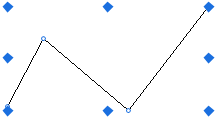 | Resizing
|
 | Rotating
|
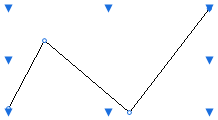 | Skewing
|
Copying and pasting objects
This is supported for a single object or multiple objects.
To copy the object:
- Click on the object or drag a box around the object with the Pointer tool
 (selection handles volition appear).
(selection handles volition appear). - To select multiple objects, click 1st object, and so press CTRL or SHIFT central down and continue the selection. Or you can drag a large box around all the objects yous desire to select.
- Press Ctrl+C, select Edit: Copy menu or right click the select object and choose Copy context menu.
To paste the object:
- On the destination page, click once where y'all want the object to be pasted, and then...
- Press CTRL + V, select Edit: Paste menu or right-click and select Paste context carte.
| |
|
Copying Line Objects and Pasting Data to a Worksheet
Any of the line objects - line, pointer, curved arrow, polyline or freehand -- can be used to generate an XY dataset:
- Select the line object in the graph, then right-click and choose Copy.
- Click on an empty worksheet cell, correct-click and choose Paste.
A set of XY coordinates volition be created in the worksheet.
Calculation Asterisk Brackets Indicating Groupings on Statistical Charts
Information technology is mutual, especially in the life sciences, to create column or bar charts and use an "asterisk bracket" object to indicate pregnant differences. Brackets can be added to an Origin graph using the Add asterisk subclass button ![]() (Add Object to Graph toolbar).
(Add Object to Graph toolbar).
- Click the Add asterisk bracket button
 to add the object to the active graph window.
to add the object to the active graph window. - Select the object then reposition it by dragging with your mouse.
-
- Use the blueish handles to size and position the bracket "legs".
- Utilise the red handles to add together curvature to bracket "shoulders".
- Note that you can manually edit the text block in the eye of the bracket to add asterisks (*), p-values, etc.
- Once selected, you can also utilise the bracket's Mini Toolbar buttons to orient the bracket, modify line thickness, etc.
-
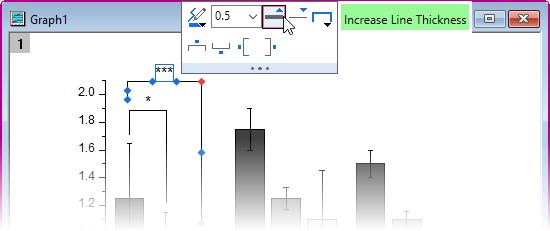
-
| | The line cap shape (round, square, flat) is controlled by LabTalk system variable @LCG. For information on irresolute the value of a arrangement variable, see this FAQ. |
Source: https://www.originlab.com/doc/Origin-Help/Create-Draw-Objects

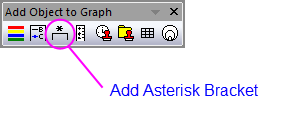
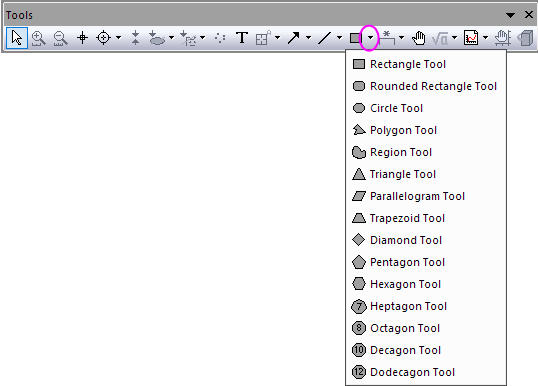
0 Response to "drawing a 3d border in publisher"
Post a Comment